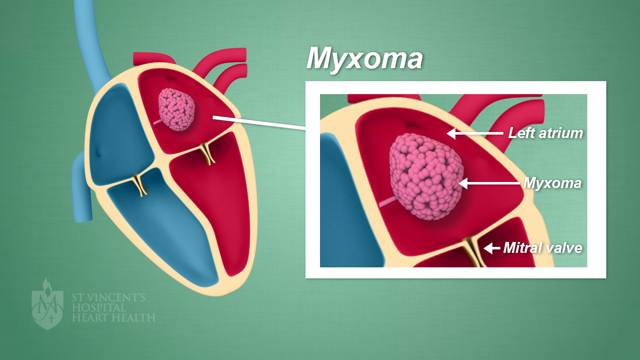Myxomas
A myxoma is a benign (non-cancerous) growth in the heart.
What is a myxoma?
What are the causes of myxomas?
What are the signs and symptoms of myxomas?
What are the possible tests to detect myxomas?
What are the possible procedures and treatments for myxomas?
What is the future plan if you have a myxoma?
What is a myxoma?
A myxoma is a benign (non-cancerous) growth in the heart. Myxomas can be as small as a few millimetres or grow to a few centimetres.
Most myxomas develop in the area of the heart called the atrium, which is the top left chamber of the heart. These myxomas grow from a stalk on the wall that separates the two sides of the heart (called the septum).
You can see an example of this in the image below.

Myxomas can swing freely. Sometimes, they can move in and out of the nearby mitral valve as the heart pumps. Rarely, this may interrupt the blood flow through the heart.
What are the causes of myxomas?
Myxomas are rare, and researchers still aren’t sure what causes them. They occur more commonly in females and people aged 40 and above. Around 10% of myxomas are thought to be passed down through families (genetic).
What are the signs and symptoms of myxomas?
Many people with myxomas don’t have any symptoms. People with symptoms may feel:
- difficulty breathing when lying flat
- chest pain or tightness
- shortness of breath with activity
- coughing
- dizziness
- fainting
- palpitations
- fevers
- tiredness
- flu-like illness
- stroke-like symptoms
Sometimes, small particles can break off from the myxoma and cause symptoms. Symptoms will vary depending on the size and the location of the myxoma.
What are the possible test to detect myxomas?
A myxoma is usually diagnosed through testing. If you’re noticing heart-related symptoms, your doctor will examine your heart, ask you about your symptoms and medical history, and order tests.
Common tests to diagnose a myxoma include:
What are the possible procedures and treatments for myxomas?
Although myxomas are benign, they can cause risks if left untreated. Parts of the myxoma can break off and travel in the bloodstream to other parts of your body, such as your brain, blocking blood flow and causing a stroke.
A myxoma that grows inside the heart can block blood flow through the valve.
Surgery is the only treatment for myxomas and should be arranged as soon as possible.
During the surgery, your surgeon will make an incision down the centre of the breastbone, or via a small incision on the chest wall, to access the heart and remove the myxoma. A heart-lung machine will temporarily take over over the function of your heart and lungs.
What is the future plan if you have a myxoma?
After surgery, your chances of returning to normal are very good. In fact, the likelihood of the myxoma recurring is rare. Still, it’s important to see your doctor regularly for follow-up appointments to monitor your heart health.